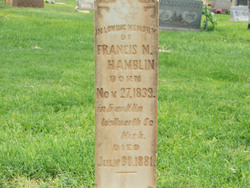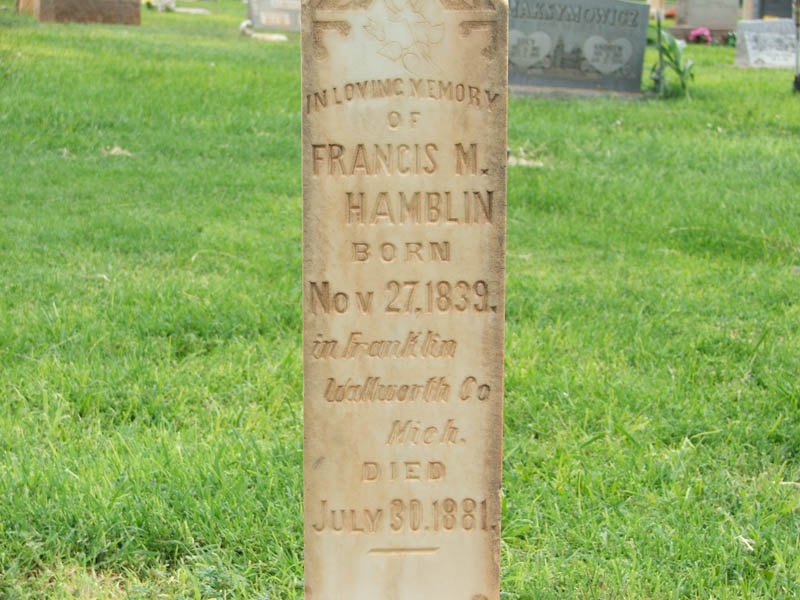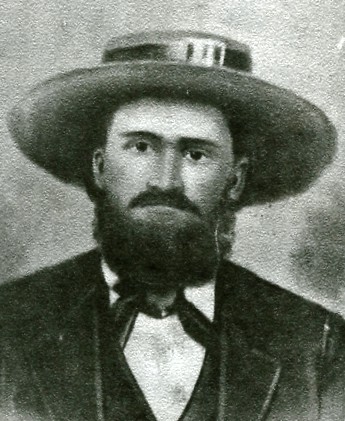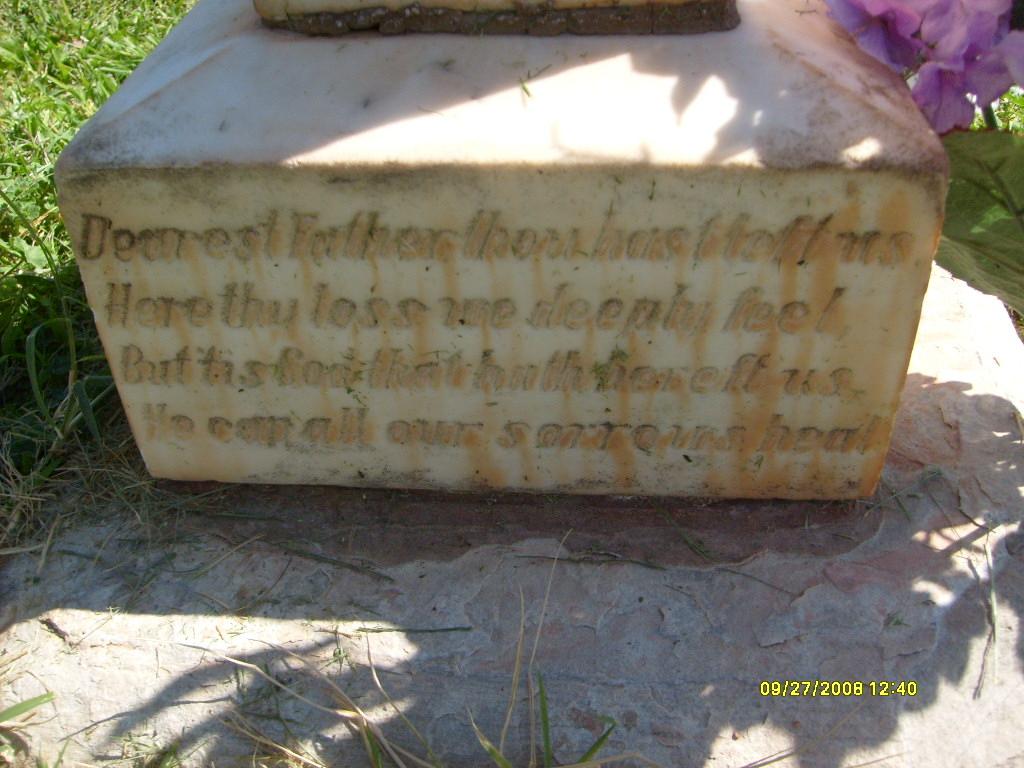Francis Marion Hamblin was born November 27, 1837 in Franklin Township, Walworth County, Michigan, the tenth of twelve children of Isaiah and Daphne Haynes Hamblin. His father was a lumberman who worked in the forests along the St. Lawrence river and westward. In the first years of the child's life his parents moved to Spring Prairie, Wisconsin; and in 1844 to Ellison, Illinois where they lived until 1845. During this time F.M's father and mother had been baptized into the Church of Jesus Christ of Later Day Saints on April 11, 1845 by their son Jacob. In the trials following the expulsion of the "Mormons" from Nauvoo, Illinois, the family moved to Pottawattamie County, Iowa. During this move, Daphne Haynes Hamblin became ill and died in 1847. She was buried along the roadside. The family lived in Iowa until 1850.
In the spring of 1850 the family started for Utah in the company of Aaron Johnson. The company was attacked by cholera and endured many hardships but arrived in Salt Lake City in September. The family lived in Tooele Valley, in a fort built to protect them from the Indians who pilfered from them at night. In 1855 they moved to a settlement on the Santa Clara River in Southern Utah.
F.M. married Arminda Elmarine Crow April 16, 1859. She died January 1 1860 in childbirth. After this tragedy in his life he prepared to go to California with his wife's family, but was prevailed upon by the authorities of the church to remain in Utah.
In the fall of 1860 he accompanied his brother Jacob Hamblin, the Indian scout, on his second trip to establish a mission in some of the Moquis towns on the east side of the Colorado River. The Party consisted of ten men including an Indian interpreter and George A. Smith Jr., son of one of the leaders of the church, and two Indian women. They went prepared to stay a year among the Indians. By the second day they had crossed the Colorado River and were about twenty miles southeast of Moan Coppy, New Mexico (now Arizona). They found themselves without water; and they were told by four Navajos that they would be killed if they pushed on to the next watering hole. They were advised to go with these four, gray-headed, Indians to the camp of Spaneshanks, a friendly Chief; but the party was so much in need of water that it decided to go on to the watering hole.
They were soon surrounded by surly Navajos from Fort Defiance determined, so the Indian interpreter gathered, on preventing their going on to Moquis towns, and debating whether to kill them or let them return to their homes. The Indians finally made a treaty with Jacob that if they would trade the goods that they had brought along and especially the ammunition, they might return home. The next morning, November 2, 1860, as they were trading for blankets, young Smith's horse wandered away, and when the young man followed it, he was shot by an Indian and left severely wounded. About forty Navajos seemed prepared to prevent their going on to the Moquis towns; so Jacob gave the order to return home. Though he begged them to leave him to die in peace, Smith was placed on a mule and held on by a man behind him. They rode as fast as they could back the way they had come with the four gray-headed Navajos, guarding their front and rear and urging them to leave the wounded boy (he was only eighteen) since the Navajos would follow them until they obtained his scalp.
George A. Smith died about sundown as they rode; and since they dared not stop to bury him, they wrapped his body in a blanket and laid it in a shallow place by the side of the road. As the rest rode northward that night, they saw far to the south a great fire burning and believed that the Navajos were having a war dance over the scalp of their friend. Next day they reached the camp of the friendly Spaneshanks, and eleven days after they left it, they were in Santa Clara, having suffered in the last few days from lack of food.
This journey seriously undermined the health of Francis Marion Hamblin. He had not fully recovered from the effects of an attack of measles when he started it. On the trip he contacted a severe cold, which settled on his lungs.
He never quite regained his health. Later he was one of the party sent to recover the bones of young Smith and helped deliver them to his parents in Salt Lake City, Utah.
On October 21, 1861, Francis Marion and Rhoda Elizabeth Lay, daughter of William Harvey and Sytha Crosby Lay, were married and sealed in the endowment house in Salt Lake City by George Cannon. Two children, Arminda and William Frederick, were born to them in Santa Clara. The church authorities sent F .M. and his family to Eagle Valley, Nevada where they ran a dairy with other settlers from Santa Clara. Here three more children were born, Francis Marion Jr., John Taylor, and Sytha Selina. John Taylor died at birth.
In 1871 they were called to move to Kanab, Utah which had been settled the year before. Here Mary Ann, Rhoda Elizabeth, Rachel Tamar, Isaiah, and Daphne Hamblin were born.
This was the town and surroundings that Francis Marion Hamblin brought his family. They lived first in a house in the fort that Jacob had just vacated and later on a lot in the town.
When major John Wesley Powell made his second expedition of exploration down the Colorado River in 1871 and 1872. F. M. Hamblin and his brothers were among those who accompanied him. It was F.M. who brought news to the party of the election of Grant, the news being delivered November 16, 1872.
In the winter of 1874 four sons of a Navajo Chief returning from a visit to the Utes were attacked by some stockman in Circle Valley (Circleville, Utah) led by a man named McCarty. Three of the Indians were killed, but the fourth severely wounded though he was by an ounce ball which passed through his body just below the shoulder blades, traveled a hundred miles over mountains and through deep snow, swam the Colorado river to tell his story to his people. The Navajos believed the Mormons to responsible for this tragedy and went upon the warpath against them. When Brigham Young heard of the affair, he sent word to Kanab to have a company raised to bring families living in Moan Coppy and the missionaries across the river. Francis Marion Hamblin was chosen captain of this company. This trouble was finally settled through the mediation of Jacob Hamblin at great personal danger to himself.
When the United Order was formed in Kanab, F.M. Hamblin joined and ran a dairy at the Swallow Park Ranch in northwestern Kane County. When the Order was disbanded, he retained the ranch and continued to make and sell cheese and butter. Sometimes cheese was hauled the 350 miles to Salt Lake City and traded for merchandise.
Zadok Knapp Judd describes the first time he met F.M. He was a tall, slender, well-built man and a bit of a dandy. He was on a fine high-spirited horse and wore a broad-rimmed hat with a wide shining band, and somewhere about him was a touch of red. He loved good-looking horses and never rode or drove any but his own. He was quick at repartee. (3)
Every Holiday in Kanab called for a dance. Dellenbaugh describes one held Christmas day 1872. "In the evening a number of us rode up to the settlement to witness a dance that had been announced to take place in the schoolhouse, tabernacle, or town-hall. The stone building in the comer of the fort which answered all of these functions. The room was about 15 by 30 feet and was lighted by three candles, a kerosene lamp, and a blazing fire on pitchy pine. Two violins were in lively operation, one being played by Lyman Hamblin, a son of old Jacob, and there was a refreshing air of decorous gaiety about the whole assemblage. Dancing is a regular amusement among the Mormons and is encouraged by the authorities as a harmless and beneficial recreation. At that time the dances were always opened with prayer. Two, sets could occupy the floor at one time and to even things up, and prevent anyone being left out, each man on entering was given a number, the numbers being called in rotation." (4)
F.M. Hamblin loved to dance and was much in demand for quadrilles and reels, which he also "called", and for his step dancing. He never waltzed. He had a fine singing voice and sang at most of the entertainments. Years later, an old man remembered hearing him sing:
" Then was it well to sever
This heart from thine forever?
I can only answer, Never
Lost, Lost Rosabelle."
Perhaps he was one of those who helped to provide music to celebrate the New Year. "January 1, 1873 was rather a dismal Holiday, even the mail which arrived this day was soaked. Toward evening the skies lifted somewhat and a four horse wagon appeared, or rather two mules and two horses on a common freighting wagon, in which Lyman Hamblin and two others were playing, as nearly in unison as possible, a fiddle, a drum, and a fife." (5)
The one existing picture of Francis Marion Hamblin shows a man with brilliant dark eyes, high cheekbones, and a short heavy beard. A flat-crowned hat with a wide brim is set squarely on his head. This hat was not in the original picture but was put there by the photographer who made and enlargement from which the smaller picture was taken.
F .M. was a religious man, keeping the word of wisdom of his church and never using tobacco, tea, coffee, or liquor in any form. Neither did he profane. At a time when polygamy among the Mormons was a rule rather than an exception, he had only one wife and declared that he wanted no more.
He died at Kanab on July 30, 1881 with "lung fever" (consumption) and is buried in the Kanab City Cemetery. He died leaving a wife and nine children, the youngest only two months old.
1. Dellenbaugh, Fredric S. A Canyon Voyage, the Narrative of the Second Powell Expedition Down the Green-Colorado River from Wyoming, and the Explorations on Land. In the years 1871-1872 New haven: Yale University, and the Explorations - pp. 166-167.
Ibid: pp 180-185.
Zadok Knapp Judd of Kanab, who in 1940 told Edna Johnson Daniels of his first meeting with her Grandfather.
Dellenbaugh-Ioc. cit., PP 173
I bid., PP 260-261
Francis Marion Hamblin was born November 27, 1837 in Franklin Township, Walworth County, Michigan, the tenth of twelve children of Isaiah and Daphne Haynes Hamblin. His father was a lumberman who worked in the forests along the St. Lawrence river and westward. In the first years of the child's life his parents moved to Spring Prairie, Wisconsin; and in 1844 to Ellison, Illinois where they lived until 1845. During this time F.M's father and mother had been baptized into the Church of Jesus Christ of Later Day Saints on April 11, 1845 by their son Jacob. In the trials following the expulsion of the "Mormons" from Nauvoo, Illinois, the family moved to Pottawattamie County, Iowa. During this move, Daphne Haynes Hamblin became ill and died in 1847. She was buried along the roadside. The family lived in Iowa until 1850.
In the spring of 1850 the family started for Utah in the company of Aaron Johnson. The company was attacked by cholera and endured many hardships but arrived in Salt Lake City in September. The family lived in Tooele Valley, in a fort built to protect them from the Indians who pilfered from them at night. In 1855 they moved to a settlement on the Santa Clara River in Southern Utah.
F.M. married Arminda Elmarine Crow April 16, 1859. She died January 1 1860 in childbirth. After this tragedy in his life he prepared to go to California with his wife's family, but was prevailed upon by the authorities of the church to remain in Utah.
In the fall of 1860 he accompanied his brother Jacob Hamblin, the Indian scout, on his second trip to establish a mission in some of the Moquis towns on the east side of the Colorado River. The Party consisted of ten men including an Indian interpreter and George A. Smith Jr., son of one of the leaders of the church, and two Indian women. They went prepared to stay a year among the Indians. By the second day they had crossed the Colorado River and were about twenty miles southeast of Moan Coppy, New Mexico (now Arizona). They found themselves without water; and they were told by four Navajos that they would be killed if they pushed on to the next watering hole. They were advised to go with these four, gray-headed, Indians to the camp of Spaneshanks, a friendly Chief; but the party was so much in need of water that it decided to go on to the watering hole.
They were soon surrounded by surly Navajos from Fort Defiance determined, so the Indian interpreter gathered, on preventing their going on to Moquis towns, and debating whether to kill them or let them return to their homes. The Indians finally made a treaty with Jacob that if they would trade the goods that they had brought along and especially the ammunition, they might return home. The next morning, November 2, 1860, as they were trading for blankets, young Smith's horse wandered away, and when the young man followed it, he was shot by an Indian and left severely wounded. About forty Navajos seemed prepared to prevent their going on to the Moquis towns; so Jacob gave the order to return home. Though he begged them to leave him to die in peace, Smith was placed on a mule and held on by a man behind him. They rode as fast as they could back the way they had come with the four gray-headed Navajos, guarding their front and rear and urging them to leave the wounded boy (he was only eighteen) since the Navajos would follow them until they obtained his scalp.
George A. Smith died about sundown as they rode; and since they dared not stop to bury him, they wrapped his body in a blanket and laid it in a shallow place by the side of the road. As the rest rode northward that night, they saw far to the south a great fire burning and believed that the Navajos were having a war dance over the scalp of their friend. Next day they reached the camp of the friendly Spaneshanks, and eleven days after they left it, they were in Santa Clara, having suffered in the last few days from lack of food.
This journey seriously undermined the health of Francis Marion Hamblin. He had not fully recovered from the effects of an attack of measles when he started it. On the trip he contacted a severe cold, which settled on his lungs.
He never quite regained his health. Later he was one of the party sent to recover the bones of young Smith and helped deliver them to his parents in Salt Lake City, Utah.
On October 21, 1861, Francis Marion and Rhoda Elizabeth Lay, daughter of William Harvey and Sytha Crosby Lay, were married and sealed in the endowment house in Salt Lake City by George Cannon. Two children, Arminda and William Frederick, were born to them in Santa Clara. The church authorities sent F .M. and his family to Eagle Valley, Nevada where they ran a dairy with other settlers from Santa Clara. Here three more children were born, Francis Marion Jr., John Taylor, and Sytha Selina. John Taylor died at birth.
In 1871 they were called to move to Kanab, Utah which had been settled the year before. Here Mary Ann, Rhoda Elizabeth, Rachel Tamar, Isaiah, and Daphne Hamblin were born.
This was the town and surroundings that Francis Marion Hamblin brought his family. They lived first in a house in the fort that Jacob had just vacated and later on a lot in the town.
When major John Wesley Powell made his second expedition of exploration down the Colorado River in 1871 and 1872. F. M. Hamblin and his brothers were among those who accompanied him. It was F.M. who brought news to the party of the election of Grant, the news being delivered November 16, 1872.
In the winter of 1874 four sons of a Navajo Chief returning from a visit to the Utes were attacked by some stockman in Circle Valley (Circleville, Utah) led by a man named McCarty. Three of the Indians were killed, but the fourth severely wounded though he was by an ounce ball which passed through his body just below the shoulder blades, traveled a hundred miles over mountains and through deep snow, swam the Colorado river to tell his story to his people. The Navajos believed the Mormons to responsible for this tragedy and went upon the warpath against them. When Brigham Young heard of the affair, he sent word to Kanab to have a company raised to bring families living in Moan Coppy and the missionaries across the river. Francis Marion Hamblin was chosen captain of this company. This trouble was finally settled through the mediation of Jacob Hamblin at great personal danger to himself.
When the United Order was formed in Kanab, F.M. Hamblin joined and ran a dairy at the Swallow Park Ranch in northwestern Kane County. When the Order was disbanded, he retained the ranch and continued to make and sell cheese and butter. Sometimes cheese was hauled the 350 miles to Salt Lake City and traded for merchandise.
Zadok Knapp Judd describes the first time he met F.M. He was a tall, slender, well-built man and a bit of a dandy. He was on a fine high-spirited horse and wore a broad-rimmed hat with a wide shining band, and somewhere about him was a touch of red. He loved good-looking horses and never rode or drove any but his own. He was quick at repartee. (3)
Every Holiday in Kanab called for a dance. Dellenbaugh describes one held Christmas day 1872. "In the evening a number of us rode up to the settlement to witness a dance that had been announced to take place in the schoolhouse, tabernacle, or town-hall. The stone building in the comer of the fort which answered all of these functions. The room was about 15 by 30 feet and was lighted by three candles, a kerosene lamp, and a blazing fire on pitchy pine. Two violins were in lively operation, one being played by Lyman Hamblin, a son of old Jacob, and there was a refreshing air of decorous gaiety about the whole assemblage. Dancing is a regular amusement among the Mormons and is encouraged by the authorities as a harmless and beneficial recreation. At that time the dances were always opened with prayer. Two, sets could occupy the floor at one time and to even things up, and prevent anyone being left out, each man on entering was given a number, the numbers being called in rotation." (4)
F.M. Hamblin loved to dance and was much in demand for quadrilles and reels, which he also "called", and for his step dancing. He never waltzed. He had a fine singing voice and sang at most of the entertainments. Years later, an old man remembered hearing him sing:
" Then was it well to sever
This heart from thine forever?
I can only answer, Never
Lost, Lost Rosabelle."
Perhaps he was one of those who helped to provide music to celebrate the New Year. "January 1, 1873 was rather a dismal Holiday, even the mail which arrived this day was soaked. Toward evening the skies lifted somewhat and a four horse wagon appeared, or rather two mules and two horses on a common freighting wagon, in which Lyman Hamblin and two others were playing, as nearly in unison as possible, a fiddle, a drum, and a fife." (5)
The one existing picture of Francis Marion Hamblin shows a man with brilliant dark eyes, high cheekbones, and a short heavy beard. A flat-crowned hat with a wide brim is set squarely on his head. This hat was not in the original picture but was put there by the photographer who made and enlargement from which the smaller picture was taken.
F .M. was a religious man, keeping the word of wisdom of his church and never using tobacco, tea, coffee, or liquor in any form. Neither did he profane. At a time when polygamy among the Mormons was a rule rather than an exception, he had only one wife and declared that he wanted no more.
He died at Kanab on July 30, 1881 with "lung fever" (consumption) and is buried in the Kanab City Cemetery. He died leaving a wife and nine children, the youngest only two months old.
1. Dellenbaugh, Fredric S. A Canyon Voyage, the Narrative of the Second Powell Expedition Down the Green-Colorado River from Wyoming, and the Explorations on Land. In the years 1871-1872 New haven: Yale University, and the Explorations - pp. 166-167.
Ibid: pp 180-185.
Zadok Knapp Judd of Kanab, who in 1940 told Edna Johnson Daniels of his first meeting with her Grandfather.
Dellenbaugh-Ioc. cit., PP 173
I bid., PP 260-261
Family Members
Advertisement
Explore more
Sponsored by Ancestry
Advertisement


























